US Monetary Policy: Shaping Global Economic Trends

Changes in US monetary policy significantly influence global economic trends, impacting international trade, capital flows, and financial stability across diverse nations and markets.
Understanding US monetary policy is crucial for anyone keen on deciphering the complex web of global economics. Decisions made by the Federal Reserve in Washington D.C. don’t merely affect American households and businesses; their ripple effects are felt across continents, influencing everything from currency values and commodity prices to investment flows and economic growth rates worldwide.
The Federal Reserve’s Role and Tools
The Federal Reserve, often dubbed the ‘Fed,’ serves as the central bank of the United States. Its primary mandates are to foster maximum employment, stable prices, and moderate long-term interest rates. To achieve these goals, the Fed employs a suite of monetary policy tools that, though domestically focused, possess potent international implications.
The Fed’s actions are meticulously watched by central banks, governments, and investors globally, as they often signal the direction of the world’s largest economy. The decisions it makes, particularly regarding interest rates, can either stimulate or cool down economic activity, with direct consequences for international capital flows and trade balances.
Key Monetary Policy Instruments
The Federal Reserve primarily uses several tools to implement its monetary policy. Each tool has a specific mechanism through which it influences the money supply and credit conditions in the US economy, and by extension, the global financial system.
- Federal Funds Rate: This is the target rate for overnight lending between banks. Adjustments to this rate influence other interest rates throughout the economy, from mortgages to corporate loans, directly affecting borrowing costs and investment decisions.
- Quantitative Easing (QE) and Tightening (QT): QE involves large-scale asset purchases by the Fed to inject liquidity into the financial system and lower long-term interest rates. QT is the reverse, reducing the Fed’s balance sheet to absorb liquidity and potentially raise long-term rates.
- Reserve Requirements: These are the portions of deposits that banks must hold in reserve, rather than lend out. While less frequently used now, changes to reserve requirements can significantly impact the amount of money banks have available for lending.
- Discount Rate: The interest rate at which commercial banks can borrow money directly from the Federal Reserve. This rate serves as a backstop for bank liquidity and can signal the Fed’s stance on monetary policy.
The effectiveness of these tools lies in their ability to influence market expectations and investor behavior, both domestically and internationally. When the Fed signals a shift in its policy stance, global markets often react swiftly, anticipating changes in asset prices and currency valuations.
In conclusion, the Federal Reserve’s operational framework and its strategic deployment of monetary tools are central to understanding not only the US economic landscape but also its far-reaching global financial implications. These tools are the levers through which the Fed attempts to steer the economy toward its dual mandate, with each adjustment sending ripples across international borders.
Interest Rate Changes and Global Capital Flows
One of the most immediate and impactful ways US monetary policy affects the global economy is through changes in interest rates. When the Federal Reserve raises or lowers the federal funds rate, it alters the attractiveness of dollar-denominated assets, triggering significant shifts in capital flows across borders.
Higher US interest rates, for instance, make investing in US bonds and other financial instruments more appealing to international investors seeking better returns. This increased demand for dollar assets typically leads to an appreciation of the US dollar. Conversely, lower US interest rates can reduce the attractiveness of dollar assets, potentially leading to capital outflows and a depreciation of the dollar.
Impact on Emerging Markets
Emerging markets are particularly susceptible to these shifts. When US interest rates rise, capital tends to flow out of emerging economies and into the US, a phenomenon often referred to as ‘capital flight.’ This can lead to:
- Currency Depreciation: Emerging market currencies weaken against the dollar, making imports more expensive and potentially fueling inflation.
- Higher Borrowing Costs: Governments and corporations in emerging economies often borrow in US dollars. A stronger dollar and higher US interest rates increase the cost of servicing these debts, diverting resources from investment and development.
- Reduced Investment: Capital outflows can shrink the pool of available funds for domestic investment, hindering economic growth and job creation.
Conversely, when US interest rates are low, capital may flow into emerging markets, seeking higher yields. While this can stimulate growth, it also carries risks, such as asset bubbles and increased foreign debt exposure, which can become problematic when US policy reverses.

The sensitivity of global capital flows to US interest rate differentials underscores the interconnectedness of the world’s financial systems. Investors constantly seek the optimal balance between risk and return, and US monetary policy often serves as a key determinant in their decision-making processes. These dynamics can create periods of significant volatility and challenge for policymakers in nations heavily reliant on foreign capital.
In essence, the Federal Reserve’s stance on interest rates acts as a powerful magnet, drawing or repelling global capital. This mechanism profoundly influences the financial health and economic trajectories of countries far beyond the United States’ borders, making global capital flows a critical channel through which US monetary decisions resonate worldwide.
Currency Valuation and International Trade
The value of the US dollar, heavily influenced by US monetary policy, plays a pivotal role in shaping international trade dynamics. A stronger dollar makes US exports more expensive for foreign buyers and imports cheaper for American consumers, impacting trade balances and competitiveness globally.
When the Federal Reserve tightens monetary policy, typically by raising interest rates, the dollar tends to strengthen. This appreciation can make goods produced in the US less attractive in international markets, potentially leading to a decline in US exports. Simultaneously, foreign goods become more affordable for US consumers, which can boost imports. This scenario can widen the US trade deficit, while potentially benefiting countries that export to the US.
Competitive Devaluation and Trade Wars
Conversely, a weaker dollar, often a result of looser US monetary policy, makes US exports more competitive and imports more expensive. This can stimulate US export growth and reduce imports, potentially narrowing the trade deficit. However, a significant depreciation of the dollar can also prompt other countries to engage in ‘competitive devaluations’ of their own currencies to maintain their export competitiveness, potentially triggering trade tensions or even ‘currency wars.’
The impact of currency fluctuations extends beyond just the volume of trade; it also affects the profitability of multinational corporations and the pricing of global commodities. For example:
- Commodity Prices: Many global commodities, such as oil, are priced in US dollars. A stronger dollar makes these commodities more expensive for countries using other currencies, which can increase their import costs and fuel inflation.
- Corporate Earnings: US multinational companies earn revenues in foreign currencies. When these revenues are converted back into a stronger dollar, their reported earnings can decline, impacting stock performance and investment decisions.
- Global Supply Chains: Currency volatility can disrupt global supply chains by altering the cost of raw materials and finished goods, forcing businesses to adjust their sourcing and pricing strategies.
The intricate relationship between US monetary policy, dollar valuation, and international trade means that every decision by the Fed has a direct bearing on the global economic landscape. Countries with significant trade ties to the US, or those heavily reliant on dollar-denominated commodities, must constantly adapt to these currency shifts, which can either present opportunities or pose substantial economic challenges.
Ultimately, the Fed’s management of monetary policy directly influences the global balance of trade and the economic fortunes of nations worldwide, making currency valuation a critical channel through which US economic decisions propagate internationally.
Inflationary Pressures and Global Price Stability
The Federal Reserve’s dual mandate includes maintaining stable prices, primarily by controlling inflation within the US economy. However, the success or failure of US monetary policy in managing domestic inflation has significant spillover effects on global price stability and inflation rates around the world.
When the Fed implements expansionary monetary policy, such as lowering interest rates or engaging in quantitative easing, it aims to stimulate demand and economic activity. While this can boost growth, it also carries the risk of igniting inflationary pressures within the US. Given the size and interconnectedness of the US economy, domestic inflation can easily translate into global inflation through several channels.
Channels of Inflation Transmission
The transmission of US inflation to the rest of the world occurs through various mechanisms, including:
- Imported Inflation: As the largest importer globally, US demand for goods and services can push up international prices. If US inflation leads to higher prices for goods produced abroad and then imported into the US, other countries may also experience increased import costs.
- Commodity Prices: A weaker dollar, often a result of expansionary US monetary policy, can make dollar-denominated commodities like oil and other raw materials cheaper for US buyers. This can increase demand and drive up global commodity prices, impacting countries worldwide.
- Expectations: Global financial markets and businesses often look to the US for cues on economic trends. If US inflation expectations rise, it can influence global inflation expectations, leading to higher wage demands and price increases in other countries.
- Exchange Rates: A depreciating dollar can make imports more expensive for US consumers, but for countries whose currencies appreciate against the dollar, their exports become more expensive, potentially reducing demand and creating disinflationary pressures in those economies.
On the other hand, if the Fed aggressively tightens monetary policy to combat high inflation, it can lead to a stronger dollar and slower US economic growth. This can have disinflationary effects globally, as weaker US demand reduces upward pressure on international prices and a stronger dollar makes dollar-denominated goods cheaper for other nations.

The interplay between US monetary policy and global inflation highlights the Fed’s immense responsibility. Its decisions not only shape the economic environment for American citizens but also have profound implications for the cost of living and economic stability for billions worldwide. Maintaining a delicate balance between growth and price stability in the US is therefore a global concern.
Consequently, monitoring US inflation trends and the Federal Reserve’s policy responses is paramount for central banks and policymakers globally, as these factors are crucial determinants of their own domestic price stability objectives. The Fed’s actions are a key variable in the complex equation of global inflationary dynamics.
Policy Synchronization and Divergence
The global economic landscape often sees periods of both policy synchronization and divergence among major central banks, particularly in response to changes in US monetary policy. When the Federal Reserve shifts its stance, other central banks face a critical decision: to follow suit, or to chart their own course based on domestic economic conditions.
Policy synchronization occurs when other central banks adjust their own interest rates or monetary tools in a similar direction to the Fed. For example, if the Fed raises interest rates to curb inflation, other central banks might also tighten their policies to prevent capital outflows or to manage imported inflation. This can lead to a coordinated global monetary tightening or easing cycle, which can either amplify or mitigate the effects of US policy.
Challenges of Policy Divergence
However, policy divergence can also arise when domestic economic conditions in other countries necessitate a different approach. For instance, if the US economy is overheating and the Fed is raising rates, but a European economy is facing recessionary pressures, the European Central Bank (ECB) might choose to maintain or even lower rates. This divergence can create significant challenges:
- Exchange Rate Volatility: Differing interest rate paths can lead to substantial currency fluctuations, impacting trade competitiveness and financial stability.
- Capital Flow Imbalances: A significant interest rate differential can trigger large capital flows, potentially destabilizing financial markets in countries with divergent policies.
- Policy Effectiveness: The effectiveness of a central bank’s domestic policy can be undermined by external monetary conditions, particularly those emanating from the US.
The decision to synchronize or diverge often depends on a country’s economic structure, its reliance on foreign trade and capital, and its specific inflation and growth targets. Emerging markets, with their greater vulnerability to capital flows, often find themselves in a more challenging position when US policy diverges significantly from their own domestic needs.
Central banks globally are constantly assessing the implications of the Fed’s actions, striving to find the optimal balance between maintaining domestic economic stability and responding to external pressures. This ongoing calibration underscores the intricate dance between national sovereignty in monetary policy and the undeniable influence of the world’s largest economy.
In summary, the choice between synchronizing with or diverging from US monetary policy is a constant tightrope walk for global central banks, with each path carrying its own set of risks and rewards that fundamentally shape their respective economic futures.
Global Financial Stability and Risk Management
The stability of the global financial system is inextricably linked to the policies enacted by the Federal Reserve. Changes in US monetary policy can either foster stability or introduce significant risks, requiring careful management by international institutions and individual nations.
When the Fed’s policies are predictable and clearly communicated, they tend to reduce market uncertainty, contributing to global financial stability. However, abrupt or unanticipated shifts can trigger volatility in financial markets worldwide, potentially leading to crises. For example, a sudden tightening of US monetary policy can expose vulnerabilities in highly indebted countries or those with large current account deficits, leading to capital flight and financial distress.
Systemic Risks and International Cooperation
The interconnected nature of global finance means that a crisis originating from US monetary policy shifts can quickly spread across borders, creating systemic risks. These risks necessitate robust international cooperation and proactive risk management strategies. Key aspects include:
- Macroprudential Policies: Countries implement measures like capital controls, stricter lending standards, and foreign exchange reserves to cushion their economies against external shocks stemming from US policy changes.
- International Coordination: Forums like the G7, G20, and the International Monetary Fund (IMF) provide platforms for central banks and finance ministers to discuss policy intentions and coordinate responses to global economic challenges.
- Early Warning Systems: International organizations monitor global financial indicators to identify potential vulnerabilities and provide early warnings of impending risks, allowing countries to prepare for policy shifts.
The ‘taper tantrum’ of 2013, when the Fed signaled a potential reduction in its quantitative easing program, serves as a stark reminder of how sensitive global markets are to US monetary policy communication. The mere prospect of tighter policy led to significant capital outflows from emerging markets and increased financial market volatility, even before any actual policy changes were implemented.
Managing global financial stability in the face of evolving US monetary policy requires a delicate balance of domestic resilience building and international collaboration. Countries must continuously assess their exposure to dollar-denominated debt, foreign capital flows, and exchange rate fluctuations to mitigate potential adverse impacts.
In essence, the Federal Reserve’s policy decisions are a major determinant of global financial health. The effectiveness of global risk management hinges on the ability of nations to anticipate, adapt to, and collectively respond to these powerful monetary shifts, ensuring resilience in an increasingly interconnected world.
Future Outlook and Adaptations
Looking ahead, the influence of US monetary policy on global economic trends is expected to remain profound, though its dynamics might evolve. As the global economic landscape continues to shift, with the rise of new economic powers and increasing geopolitical complexities, the channels through which US policy impacts the world may also change.
One significant trend is the increasing diversification of global trade and financial flows, potentially reducing the singular dominance of the US dollar in some respects. However, the dollar’s role as the primary reserve currency and in international transactions ensures that Federal Reserve actions will retain their critical importance for the foreseeable future.
Adapting to a Changing Global Environment
Countries and international institutions are continually seeking ways to adapt to and mitigate the effects of US monetary policy shifts. Key adaptations and considerations for the future include:
- Building Resilience: Strengthening domestic financial systems, accumulating foreign exchange reserves, and reducing reliance on dollar-denominated debt can help countries weather external shocks.
- Regional Economic Integration: Enhanced regional trade agreements and financial cooperation can provide a buffer against external volatility, fostering more localized economic stability.
- Diversification of Reserve Currencies: While challenging, some nations are exploring the diversification of their foreign exchange reserves away from an over-reliance on the US dollar, though this is a long-term and complex process.
- Technological Advances: The emergence of digital currencies and new payment systems could, in the long run, alter the mechanisms of international capital flows and the influence of traditional monetary policies.
The Federal Reserve itself is also adapting, increasingly considering the international implications of its decisions and communicating its policy intentions more transparently. This greater awareness and communication can help reduce unforeseen global market reactions, though the inherent power of its policies remains.
Furthermore, the ongoing debate about the appropriate level of inflation, the role of fiscal policy, and the impact of climate change on economic stability will likely shape future monetary policy frameworks, both in the US and globally. These broader trends will interact with the Fed’s policy choices, creating a multifaceted environment for global economic management.
In conclusion, while the foundational influence of US monetary policy persists, the global economic system is not static. Continuous adaptation, strategic planning, and international dialogue will be essential for navigating the evolving landscape and harnessing the benefits while managing the risks associated with the Fed’s powerful economic levers.
| Key Impact Area | Brief Description of US Monetary Policy Influence |
|---|---|
| Global Capital Flows | US interest rate changes attract or repel international capital, affecting investment and financial stability worldwide. |
| Currency Valuation | Fed policies influence the dollar’s strength, impacting global trade competitiveness and the cost of dollar-denominated assets. |
| Inflationary Pressures | US inflation can spill over globally through commodity prices and demand, affecting price stability across nations. |
| Policy Coordination | Other central banks often synchronize or diverge from US policy, creating challenges or opportunities for global economic management. |
Frequently asked questions about US monetary policy
The Federal Reserve’s primary goals for US monetary policy are to promote maximum employment, maintain stable prices (control inflation), and ensure moderate long-term interest rates. These objectives guide their decisions on interest rates and other financial tools to foster a healthy economic environment.
When the US raises interest rates, it makes dollar-denominated assets more attractive, often leading to capital flowing out of other countries, especially emerging markets. This can weaken foreign currencies, increase borrowing costs for dollar-denominated debt, and potentially slow down economic growth abroad.
A strong US dollar generally makes US exports more expensive for foreign buyers, potentially harming US export competitiveness. Conversely, it makes imports cheaper for US consumers. For other countries, it can make their exports to the US more competitive but increases the cost of dollar-denominated imports like oil.
Quantitative Easing (QE) involves the Fed buying large quantities of government bonds and other assets to inject liquidity into the financial system and lower long-term interest rates. Globally, QE can lead to capital flows into riskier assets in other countries, potentially boosting their economies but also creating asset bubbles or currency appreciation pressures.
Central banks outside the US often face a dilemma: either synchronize their policies with the Fed to mitigate capital flow disruptions and currency volatility, or diverge to address unique domestic economic conditions. Their reaction depends on their economic structure, inflation targets, and reliance on international capital.
Conclusion: Navigating an Interconnected Economic Future
The intricate relationship between US monetary policy and global economic trends is undeniable and continues to be a central pillar of international finance. The Federal Reserve’s decisions, from adjusting interest rates to implementing unconventional tools like quantitative easing, send powerful signals that reverberate across continents, shaping capital flows, currency valuations, trade dynamics, and inflationary pressures worldwide. Understanding these mechanisms is not just an academic exercise; it is a vital necessity for policymakers, investors, and businesses operating in an increasingly interconnected global economy. As the world continues to evolve, characterized by technological advancements and shifting geopolitical landscapes, the influence of US monetary policy will undoubtedly adapt, but its fundamental role as a primary driver of global economic conditions will remain paramount.





